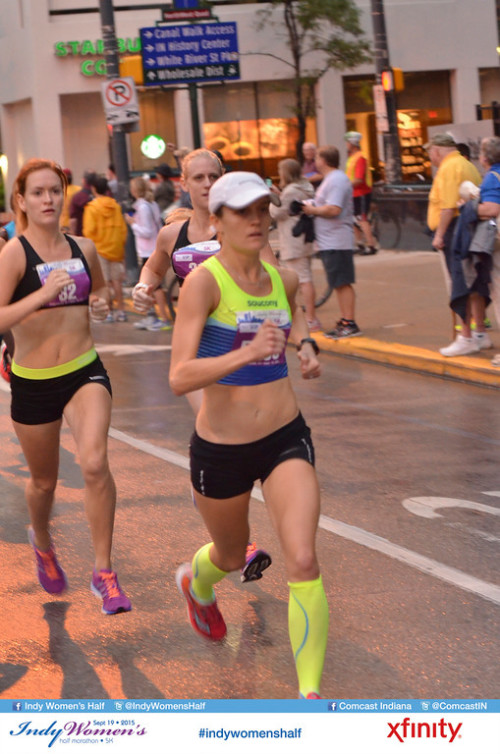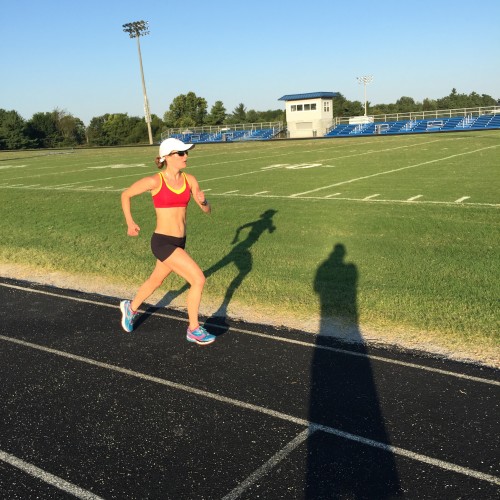We have all heard it; the running is 90 percent mental quote.
Only 10 percent is actually about the training. Although we know deep down that the physical side of training is in fact more important than just 10%, we all know the point that quote is trying to make:
The mental aspect of running can make or break a race for us.
We can build our running mental toughness using some of the mental running strategies I talked about in my article in this Guardian about battling demons, but sometimes, is it really toughness we need?
I have talked about how I have been spending a lot of my runs wondering not just why I am not getting faster at running, but why I am running slower than before.
When you are going through this, it is difficult to wrap your mind around it.
Why is why is my running pace getting slower when I am doing all the training?
Do you mind if I get in your face a little here, and suggest something that could help?
Could it be that your training pace vs race pace are not quite different enough, you need to learn how to run a slower pace (and be okay with it)?
Finding the Right Running Paces for Training
Its a tough pill to swallow, is my pace really that off?
Maybe, maybe not.
However, if training has been a struggle for you lately, the effort scale might be just what you need to take the pressure off, and just focus on doing the right thing each day.
What is the effort scale of running?
Let me explain:
I can talk about this for hours right now, because I have had to rely on the effort scale a lot these past few months. If I didn’t, my confidence would continue to spiral out of control, and the mental training tips I recommend to others, would essentially be useless, as I couldn’t even follow them myself.
Steve and I use the effort scale almost on a daily basis, and here is what it comes down to:
Remove the pace aspect of your running for just a minute. That means you will NOT look at your GPS watch for any of your training. If the temptation of looking when you have it on your wrist is too much, you may need to switch to a running for time style of training for a little while.
Now, let’s think about training in terms of a scale of 1-10, where 1 would be a very light jog you would use in between repeats, or how you would run if you were waiting to cross a road at a traffic light. A pace that is so easy, you are literally barely moving.
Just for some perspective:
For me, that is around 3-4 minutes per mile slower than my marathon pace, or 4-5 minutes slower per mile than my 5k pace.
On the other end of the scale, a 10 would be your final 400m of a race.
“Balls to the wall”. All out. Everythin’ you got (to quote my favorite Rocky Balboa movie!).
Now, sit down and break the rest of your training down between the rest:
An easy, recovery run (most of your training!) should sit at a 3/10 effort.
Now, think for a moment about how far that is away from a 10.
That means most of your training should not be halfway to your all out effort, it should be only 1/3 of your all out effort.
Steady state runs, where you are breathing a little hard, you have to use some effort to maintain, but feel strong, will sit at a 5/10.
The first half of a marathon, first 5-6 miles of a half marathon, or first mile of a 5k will sit around a 7. A pace you could hold for 1-4 miles. Most of my workouts end up around this effort level.
Efforts 9 and 10 are reserved for races only, and I will only touch an 8/10 for the final few minutes of a hard training day.
How to use the effort scale
I will give you an example of my training over the last week to show you where my training falls on the scale.
Recovery runs (3 of the 7 days of the week), sit at a 3, as does the warm up for any hard workout days.
One of the recovery runs, I felt pretty good, so I was able to move into a 4 and run a little faster, but was still breathing very comfortably, still using the tips I mentioned before about how to know if you are running easy enough.
My long run spent most of the time at a 3-4, with the final 3-4 miles sitting at a 5.
The two workouts for the week went like this:
Speed day: 4 miles of 400m-800m repeats
1.5 mile at 6 effort
3x800m at 7 effort
4x400m at 7-8 effort
Longer repeat day: 8.5 miles of 1 mile to 3 mile repeats
3 miles at 5-6 effort,
3 miles at 6-7 effort
1.5 miles at 7 effort
1 mile at 7-8 effort
Why is effort based training better than using paces?
I know what you are thinking:
Any of these sound familiar?
Why would I use this, rather than specific paces? I need to run my race pace. I need to get my body ready for the race, and if I can’t do it in training, how am I going to do it in a race?
Well, as I have talked about many times before, maybe your self doubt is sabotaging things for you.
Maybe you could be training EVEN FASTER than your paces, but if you saw the clock, you would panic and think it was only a matter of time before you blew up.
Guilty. I do this whenever I see a time that is too fast.
Whereas if you just ran by effort, you could have trained all your workouts faster than you think, and then come race day, you turn that GPS pace away from your wrist, and SMASH your race day goal, as you allowed your body to truly run its potential!
If you have been following paces, and feel strong, confident, ready to go for your race, this is not going to be the best thing for you. By all means keep going with your paces.
Actually, thats a lie, I believe everyone could benefit from this type of training, but if things are going great for you, you don’t need to listen to me today. Save this post for a day you need it (if ever!)
But:
If you have been struggling in training lately. If you have been wondering why you are getting slower. If you have been really having a hard time with your mental training and toughness, well, I would encourage you to join me and use effort based training for a little while.
At the end of the day, this type of training will test your mental strength in a different way. It will force you out of your comfort zone, as you are not able to rely on the GPS to tell you that you are running the right running pace, and that will make you feel stressed for a few runs, BUT I guarantee you, you will learn to listen to what your body is telling you.
You will learn to trust yourself more, and build your confidence, as you know that all you are doing is your best, and that really is all we can do in running.
Step away from the technology (remember, you do not have to remove it, you can still wear that GPS watch, just don’t look at it during your training). You can still log it on Strava or in your training log, but let the running take care of itself during the actual run, and THEN go back and look (if you need to).
If you cannot resist looking, then it is time to bring out the watch.
Convert your distances of repeats into time. If you have 6 x 1 mile at 9 minute pace, convert that to 6 x 9 minutes of running. For reference, I would say that kind of workout should have you working around a 6/10 for the first 3 repeats, 7/10 on the next 2 repeats, and the final one creeping into an 8.
If you have an easy, recovery run of 6 miles that usually takes you an hour, run for an hour (or if you really need to, add a few minutes to make sure you get the distance).
You will find that you end up with less injuries, you feel better on the hard days, and your confidence SKYROCKETS as you know you are doing all you can to run well, and that will give you a peace of mind to know there is nothing more you can do.
Let race day be the day you really find out how strong you are, the training is just the journey you use to get to that point.
Believe in you my friends, and let your strength shine through. Let your running do the talking, not your head!
How to Use the Effort Scale Cheatsheet
Get your printout to refer to as you begin effort based training
Let me know how it is going, share with me in the Running for Real Facebook Group, tweet at me how you are feeling, email me if you like. I can be that person for you who lets you know that you are on the right track.
Oh, and download that cheatsheet above, I broke it down into each of the 10 levels and what type of runs will fit into each. It should be really helpful…and if it isn’t, please let me know, and I will see what I can change to MAKE it helpful





8 Comments.
So freaking helpful. I did 20 miles yesterday and lean super hard on my rate of perceived exertion. Because I wasn’t really watching the miles, I was focused on the steps, and forward movement
I have used this method for so long that is was hard for me to start HR monitor training! But now? My HR is usually spot on to my rate of perceived exertion and, I can always tell when I’m overtired Thanks Tina!!
Thanks Tina!!
I am by no means an elite runner. I tend to simplify it to Green-Yellow-Red. Green is easy pace, Yellow is tough but sustainable, Red is balls-out (anaerobic).
The color system, which I first heard about on a podcast by Coach Jenny Hadfield (credit where credit is due), is a pretty good way to pace yourself, for people who don’t want all the minute details of numbers. I was in a half marathon last week, facing 20-40 mph winds so my actual pace times were discouraging, but I thought about keeping the effort in the orange to red zone for the last four miles and I did OK – 2-3 minutes slower than ideal pace, but overall not bad.
Did a half marathon on Friday and left my garmin behind, though I had a watch (and i did check it each km… but wasn’t going to panic). I was amazed at how I maintained a very consistent km pace throughout. I didn’t go into the race with any expectations, did way better than I thought and didn’t blow up, which was so much nicer than my previous race. Thanks for the advice about learning to judge pace. It really works… though i am not sure yet if i would trust myself it i was trying for a PB. As for training by effort… i stopped using my garmin in training as i was too depressed by my pace and then would get fed up…. but in the race my pace was much faster than i thought i could maintain…I mean in terms of time… I ran a speed i thought i could keep up throughout. It worked! So happy! Thansk Tina
This is definitely an area I could work on. I like to hit certain paces in my workouts and get frustrated if that pace feels extra hard one day, rather than letting my body run at the 6 or 7 and ignoring the pace.
This weekend, i ran my half blind (by accident- forgot the watch in my gear bag) and actually had a very even split solid race and 2 minute pr! So I’m recognizing I probably need to move in this direction more often!!
Tina
Excellent article, links perfectly (for runners) into my recent LinkedIn post on Time Poor – How to Make Cardio Workouts More Effective. I will definitely share your insights with our run group in Perth, WA!
Hope you’re well
So good! I can be a slave to my Garmin… then beat myself up over paces. I’ll work on this some this week!!